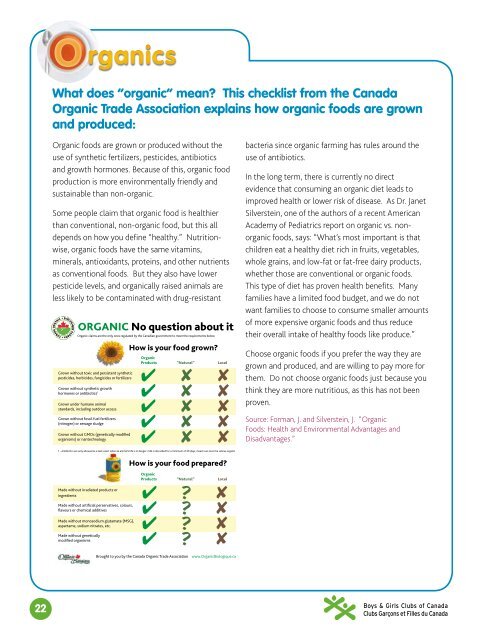Download - Boys and Girls Clubs of Canada
Download - Boys and Girls Clubs of Canada
Download - Boys and Girls Clubs of Canada
Create successful ePaper yourself
Turn your PDF publications into a flip-book with our unique Google optimized e-Paper software.
O rganicsWhat does “organic” mean? This checklist from the <strong>Canada</strong>Organic Trade Association explains how organic foods are grown<strong>and</strong> produced:Organic foods are grown or produced without theuse <strong>of</strong> synthetic fertilizers, pesticides, antibiotics<strong>and</strong> growth hormones. Because <strong>of</strong> this, organic foodproduction is more environmentally friendly <strong>and</strong>sustainable than non-organic.Some people claim that organic food is healthierthan conventional, non-organic food, but this alldepends on how you define “healthy.” Nutritionwise,organic foods have the same vitamins,minerals, antioxidants, proteins, <strong>and</strong> other nutrientsas conventional foods. But they also have lowerpesticide levels, <strong>and</strong> organically raised animals areless likely to be contaminated with drug-resistantORGANIC No question about itOrganic claims are the only ones regulated by the Canadian government to meet the requirements belowGrown without toxic <strong>and</strong> persistent syntheticpesticides, herbicides, fungicides or fertilizersGrown without synthetic growthhormones or antibiotics 1Grown under humane animalst<strong>and</strong>ards, including outdoor accessGrown without fossil fuel fertilizers(nitrogen) or sewage sludgeGrown without GMOs (genetically modifiedorganisms) or nantechnologyHow is your food grown?OrganicProducts “Natural” Local✔ ✘ ✘✔ ✘ ✘✔ ✘ ✘✔ ✘ ✘✔ ✘ ✘1 - Antibiotics are only allowed as a last resort when an animal’s life is in danger: milk is discarded for a minimum <strong>of</strong> 30 days; meant can never be sold as organicbacteria since organic farming has rules around theuse <strong>of</strong> antibiotics.In the long term, there is currently no directevidence that consuming an organic diet leads toimproved health or lower risk <strong>of</strong> disease. As Dr. JanetSilverstein, one <strong>of</strong> the authors <strong>of</strong> a recent AmericanAcademy <strong>of</strong> Pediatrics report on organic vs. nonorganicfoods, says: “What’s most important is thatchildren eat a healthy diet rich in fruits, vegetables,whole grains, <strong>and</strong> low-fat or fat-free dairy products,whether those are conventional or organic foods.This type <strong>of</strong> diet has proven health benefits. Manyfamilies have a limited food budget, <strong>and</strong> we do notwant families to choose to consume smaller amounts<strong>of</strong> more expensive organic foods <strong>and</strong> thus reducetheir overall intake <strong>of</strong> healthy foods like produce.”Choose organic foods if you prefer the way they aregrown <strong>and</strong> produced, <strong>and</strong> are willing to pay more forthem. Do not choose organic foods just because youthink they are more nutritious, as this has not beenproven.Source: Forman, J. <strong>and</strong> Silverstein, J. “OrganicFoods: Health <strong>and</strong> Environmental Advantages <strong>and</strong>Disadvantages.”Made without irradiated products oringredientsMade without artificial perservatives, colours,flavours or chemical additivesMade without monosodium glutamate (MSG),aspartame, sodium nitrates, etc.Made without geneticallymodified organismsHow is your food prepared?OrganicProducts “Natural” Local✔ ? ✘✔ ? ✘✔ ? ✘✔ ? ✘Brought to you by the <strong>Canada</strong> Organic Trade Association www.OrganicBiologique.ca22











